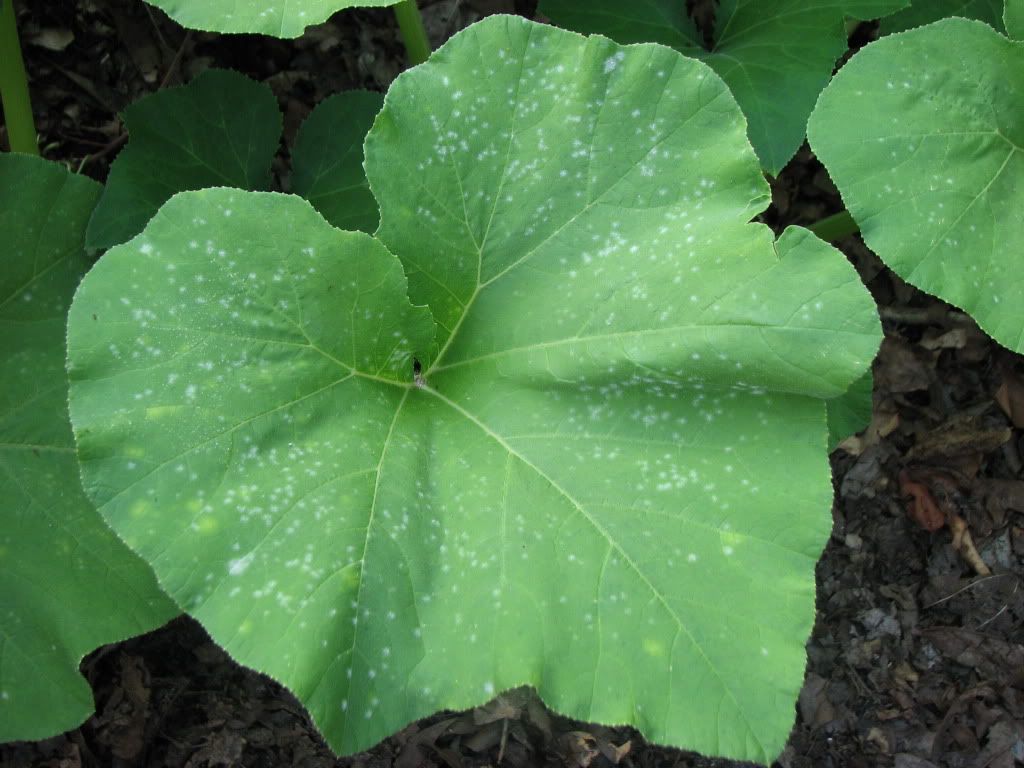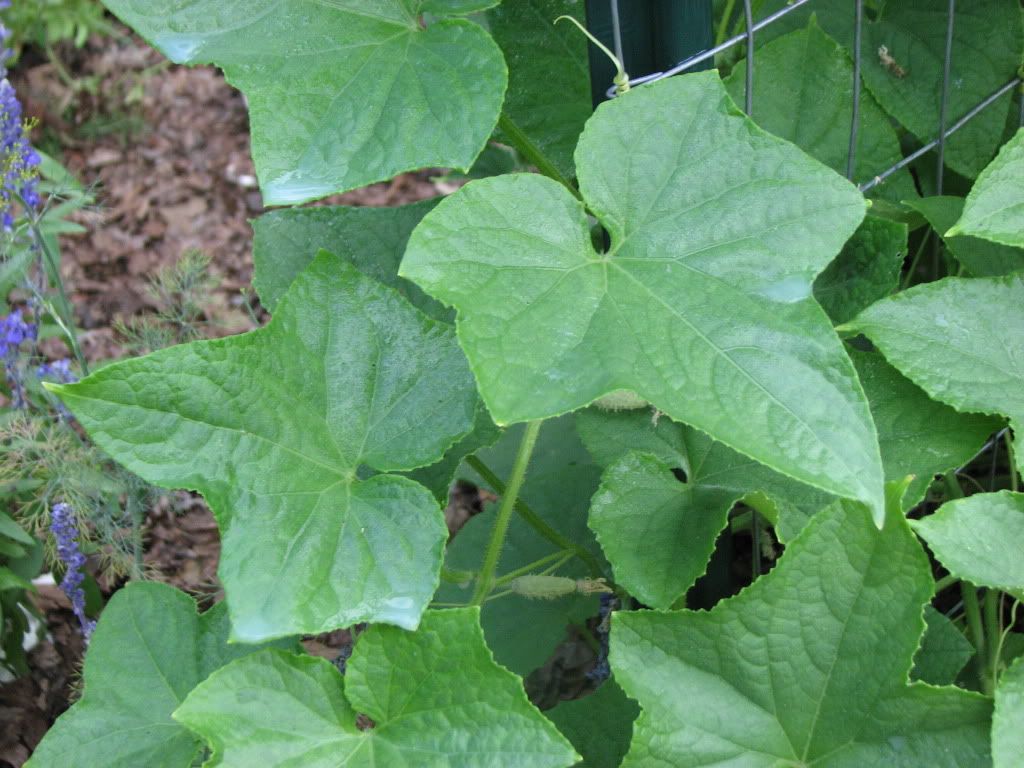How to Spray Milk to Prevent Powdery Mildew Disease
In the humid south we can usually expect plant diseases to start showing up in June and July. Some of them are difficult to manage at all, but powdery mildew (PM) has a surprisingly effective organic solution… milk!

Photo Caption: A simple sprayer and one part milk to nine parts water is around 90% effective at preventing powdery mildew.
I know, milk… it seems like one of these too-good-to-be-true crank organic remedies, right?
The September 1999 issue of Crop Protection reported about scientist Wagner Bettiol’s study on using diluted milk as a control for powdery mildew on cucurbits. Backed by Embrapa, the Brazilian Agricultural Research Corporation, the study reported that a solution of 10% – 20% raw milk in water sprayed weekly was equally effective or better than the most trusted chemical fungicides on the market (around 90% effective, depending on the plant variety’s natural disease resistance). Continued studies at the University of Adelaide in Australia seek to understand why milk works so well against powdery mildew (and also botrytis blight, which you may have seen on your squash flowers or strawberries — it’s that fuzzy mold that appears in wet conditions).
The University of Adelaide has also found that the milk solution works on crops other than cucurbits, such as grapes and roses. The full potential of this remedy is still being explored. Scientist Peter Crisp has talked about his findings with ScienceNews Online and the Australian Journal of Grape and Wine Research. The ScienceNews article also quotes professor and winemaker David Bruer saying that raw milk is not required for success. Skim milk and rehydrated powdered milk both offer the same results.
Not only is this toxin-free solution effective, it is very easy! After raiding the fridge (how do you explain this one to your family when there is no milk for cereal?), simply mix 1 part milk to 9 parts water and thoroughly coat susceptible plants once a week. (Bruer says he only sprays once every 2 weeks).
Milk sprays work best in full sun so try to do applications in the morning hours and on non-cloudy days. More isn’t better! A different mold has been found to grow on plants if the mixture contains 30% or more milk.

Photo Caption: Spa treatment! It is important to start spraying your plants when they still look healthy to get the best protection. This is how my cukes looked yesterday just prior to their milk bath.
There may be one small catch: at the Organic Growers School early this spring I learned that milk sprays in our region typically work best as a preventative rather than as a cure. They suggested keeping an indicator crop to let you know when powdery mildew has shown up in the area. PM susceptible crops that give an early heads-up are European grapes (not muscadines), zinnias, and peas. If those plants start to get sick, start spraying!
You can also keep an eye on your neighbor’s gardens. Yards with less air circulation, more shade, poorer soil nutrients, or uneven watering may come down with diseases before you see them at your house. If you see any signs of powdery white spots on the upper or lower sides of leaves, it’s time to spray.

Photo Caption: I became alerted to the presence of disease in my neighborhood when a fellow gardener down the street sent me this photo of cucumbers. Once a plant is this distressed it may not respond to milk treatment. (Note: this plant also has cucurbit downy mildew).
Once your plants get sick, it may be too late, but you can try removing the sickest leaves and then spray. Be careful, if you remove more than 1/3rd of the foliage then your green friend will also struggle to survive from a lack of energy. You may want to give your plant a dose of liquid fertilizer in addition to the milk spray to encourage replacement growth.

Photo Caption: This winter squash leaf is showing early spots from powdery mildew. If left alone the disease would soon coat the leaf, giving it a silvery appearance. Heavily infected leaves rapidly begin to curl, turn brown, and fall off the plant. Throw diseased foliage in the garbage instead of the compost pile.
If you don’t have an indicator crop on hand you can watch for the earliest signs of small, powdery white spots on your plants leaves. Or, if you’ve kept good garden records, you can start spraying a week or two prior to when your plants became ill in previous seasons.

Photo Caption: A thorough coating of milk once weekly can make normally susceptible crops all but immune to powdery mildew. Leaves should look shiny on both sides with one or two drips falling from them after you spray.
When you spray you will find that the garden suddenly has the smell of a dairy’s milk room. That smell is lactic acid being dispersed into the air. Unless you have a pronounced milk allergy there should be no need to wear the protective gear recommended for harsher fungicides. You can even feel comfortable using your bare hands to lift plant parts in order to spray the underside of the leaves. (If you’re using a new, clean sprayer and would like to give the neighbors something to talk about, try drinking some “fungicide” while they’re watching). 😉
Milk may also work as a foliar fertilizer and can feed the soil when it drips off of plants. The Columbia Daily Tribune has reported that dairy farmers are using leftover skim milk from cheese processing to fertilize their fields with tremendous results! Some of us would probably choose dentist visits and toilet cleaning over spraying the garden, but at least this chore offers a spectrum of benefits.
Also, though saving a buck on garden care is always tempting, please consider buying high quality, organic milk for your spraying needs. Inferior milk may work as well but your organic purchase votes for the integrity of farmers with well-treated, healthy cows and land.
Definitive studies only exist on a handful of crops but you can safely try milk on most plants that are in danger of powdery mildew or botrytis blight. Milk might damage plants with delicate tissue (perhaps African violets, for instance) but shouldn’t harm sturdy foliage.
Try milk to prevent PM on cucumbers, summer/winter squash, pumpkins, melons, okra, peas, beans, zinnias, crape myrtle, roses, dogwood, phlox, or any other plant that contracts this disease. Get milk!
23 thoughts on “How to Spray Milk to Prevent Powdery Mildew Disease”
Comments are closed.


melissa - July 2, 2010 7:11 pm
That’s really awesome! Thanks for sharing!!
.-= melissa´s last blog ..My Fourth Of July Garden Decor =-.
Sandra - July 2, 2010 7:30 pm
It would, probably, surprise people how those old home remedies work. I’d far rather have a home remedy than one from Monsanto, Glaxco, Dupont, etc.
Do you use epsom salts? Really great for gardens!
.-= Sandra´s last blog ..For Your Information =-.
Meredith - July 11, 2010 9:08 pm
Eliza, this is brilliant! Thanks for alerting me to this home remedy. I’m definitely going to try it. Last year all my squash went down for the count in early September — I thought due to the prolonged dry spell followed by torrential rains. Eventually, they dragged the zucchini down with them — although the cukes managed to stay clear of it, only a few feet away. I also did not know zinnia were susceptible. Good info here. Thanks!
p.s. Oh, doesn’t your garden look lovely…
.-= Meredith´s last blog ..fat cabbage =-.
Dave - August 10, 2010 4:15 am
Sandra – “It would, probably, surprise people how those old home remedies work”
Indeed it would as you just made this up.
This is NOT a ‘home remedy’. It was created by “scientist Wagner Bettiol” not someone’s grandmother. For once give scientists their due instead of looking to put them down.
On the factual side, the milk treatment is working well on my grapes at the moment but there’s a few weeks to go. Keeping fingers crossed.
Pingback: Ugh. Slugs & Snails, Aphids/White Flies, Powdery Mildew « Green Bean Connection
Pingback: How to Finish the Fall Garden | Appalachian Feet
Pingback: How to Grow and Use Achocha/Caigua (a Problem-Free Cucumber Substitute) With Recipes | Appalachian Feet
Pingback: How to Find Great Plants, Issue #4 | Appalachian Feet
Pingback: How to Feel Inspired by an Urban Farm | Appalachian Feet
Pingback: How to Prevent Squash Vine Borer and Powdery Mildew on Squash, Organically | Appalachian Feet
Kaye - December 4, 2011 11:19 pm
My experience is that sometimes you need to use baking soda and water especially if the mildew smells acidic – I understand that sometimes the weather (or other factors ) creates an acidic or alkaline environment and spraying either acidic milk or alkaline baking soda
Pingback: Post your Organic Tea Recipe! - Page 73 - Grasscity.com Forums
Pingback: How to Find Unusual Vegetables & Fruits for Zone 7b | Appalachian Feet
Karen - June 14, 2012 2:53 pm
Eliza, I have a dogwood (one that’s very important to me) that I noticed powdery mildew on a couple weeks ago. It would be quite a project to spray, but if I thought it might help I’d try. Do you think it would be worth the effort?
Sustainahillbilly
Twitter: appalachianfeet
- June 15, 2012 1:13 am
Once the powdery mildew has shown up, it is often too late (for that season). Your dogwood probably also has dogwood anthracnose, which is more of a problem for them. It could also lower the tree’s immune system and make it even more susceptible to the powdery mildew.
http://www.na.fs.fed.us/spfo/pubs/howtos/ht_dogwd/ht_dog.htm
Jessica - June 26, 2012 6:04 pm
Is it possible to use goats milk?
Sustainahillbilly
Twitter: appalachianfeet
- July 25, 2012 2:46 pm
Yes!
Pingback: Powdery Mildew and What To Do About It | Green Garden Dreams
Christine - September 13, 2012 8:19 am
This worked like magic! I have a small potted zinnia that I was sure was a goner. Noticed a patch of VERY bad powdery mildew, more like a spider web than spots, two days ago and tried to remove a little by hand while figuring out what to do. The next morning (yesterday) the whole plant was badly wilted and seemed on death’s door.
Last night (though morning is recommended I didn’t want to wait) I sprayed a 9/1 solution of water and milk all over the plant and undersides of leaves.
This morning: like new! No sign of the mildew and the entire plant is plumped up and happy again!
Am planning on using the rest on my cutting beds, which are just beginning to get spots.
Thank you, thank you!
Sustainahillbilly
Twitter: appalachianfeet
- January 16, 2013 10:13 am
That’s great!
Talida - June 30, 2013 12:38 pm
Can powdered milk be used for mildew prevention?
Pingback: Prevent Powdery Mildew | Agridude
Pingback: News: Eliza on TV, Upcoming Events, and Our Favorite “How To” Articles | Appalachian Feet